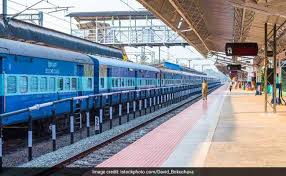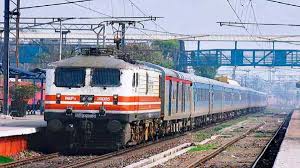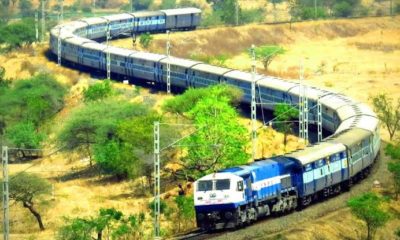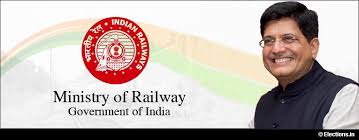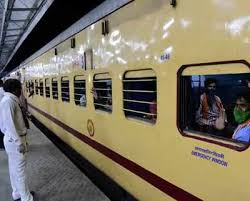Feature
Mumbai commuters gets first local AC train by Indian Railways

Mumbai: The Indian Railways on Monday flagged off the country’s first air-conditioned suburban local train for Mumbai commuters, 150 years after the first suburban local was hauled by a steam engine in 1867, officials said.
The Christmas and pre-New Year bonanza saw the first AC local’s maiden run for the media, officials, some political party activists and commuters between Borivali and Churchgate on the Western Railway (WR).
Though a public holiday, there were hundreds of curious and wide-eyed commuters who crowded the Borivali station and other stations en route, which will start full-fledged operations from January 1, 2018, with 12 daily services.
According to WR chief spokesperson Ravinder Bhakar, six return services (total 12) will operate on the suburban sector at regular intervals on all weekdays, with the weekends kept free for maintenance purposes.
As per the current plans, of these 12 daily services, eight will be operated as ‘fast trains’ on the congested Churchgate-Virar (Palghar) sector, three between Churchgate-Borivali, both with halts only at major stations, while one will ply as a slow service halting at all stations between Mahalaxmi-Borivali.
Till Friday, the WR will operate six (three in each direction) services daily on an experimental basis and introduce full 12 services from January 1.
Indian Railways flags off first AC local train for Mumbai commuters:
The WR has also announced an introductory fare to lure commuters to the new, ‘cool’ style of commuting, with the fare to be 1.2 times the cost of a first class one-way regular ticket, and later the fare will be 1.3 times.
This comes to an average minimum fare of Rs 60 and maximum of Rs 205 per single journey, and a monthly season ticket fare of between Rs 570 and Rs 2,070 for a commuter.
Manufactured by the Integral Coach Factory, Chennai, the full AC air-suspension coaches have a capacity of carrying nearly 6,000 commuters per rake, automatic door opening-closing system, LED lights, Emergency Talk Back system between commuters and guard besides a public address system, advanced GPS-based passenger information systems, speeds of up-to 100 kmph, air-tight vestibules inter-connecting all 12 coaches, other modern amenities and the latest safety features for commuters.
The development was described as “historical” for Mumbai’s lifeline, the suburban train network, which started in 1867 when the first local train was hauled by a steam engine.
However, railway history was created 14 year earlier – on April 16, 1853 – when the first train ran between Bori Bunder (now, Chhatrapati Shivaji Maharaj Terminus) to Thane, a distance of 34 km, the first in India.
Sixty one years later on January 5, 1928, the first electric EMU train on WR was introduced and the suburban network continued to grow in leaps and bounds in the past 90 years.
On May 5, 1992, the WR introduced the world’s first Ladies Special trains which have now become a regular feature and a trendsetter for similar services in India and some other countries.
Presently, the WR operates a whopping 1,355 suburban services daily transporting around 3.5 million passengers with 89 rakes in the districts of Mumbai, Thane and Palghar, besides the Central Railway servicing commuters in Mumbai, Thane, Palghar, Raigad and surroundings.
Initially, the suburban rakes had only four coaches, and were later upgraded to nine cars in 1958, but as passenger traffic increased, the WR converted all rakes to 12 cars from 1990, and introduced the first 15-car rakes – the longest suburban trains in the country, from November 2009, and the new era of airconditioned suburban travel that started on Monday.
Entertainment
Meghalaya Reserves Legalized Gambling and Sports Betting for Tourists

The State Scores Extra High on Gaming-Friendly Industry Index
Meghalaya scored 92.85 out of 100 possible points in a Gaming Industry Index and proved to be India’s most gaming-friendly state following its recent profound legislation changes over the field allowing land-based and online gaming, including games of chance, under a licensing regime.
The index by the UK India Business Council (UKIBC) uses a scale of 0 to 100 to measure the level of legalisation on gambling and betting achieved by a state based on the scores over a set of seven different games – lottery, horse racing, betting on sports, poker, rummy, casino and fantasy sports
Starting from February last year, Meghalaya became the third state in India’s northeast to legalise gambling and betting after Sikkim and Nagaland. After consultations with the UKIBC, the state proceeded with the adoption of the Meghalaya Regulation of Gaming Act, 2021 and the nullification of the Meghalaya Prevention of Gambling Act, 1970. Subsequently in December, the Meghalaya Regulation of Gaming Rules, 2021 were notified and came into force.
All for the Tourists
The move to legalise and license various forms of offline and online betting and gambling in Meghalaya is aimed at boosting tourism and creating jobs, and altogether raising taxation revenues for the northeastern state. At the same time, the opportunities to bet and gamble legally will be reserved only for tourists and visitors.
“We came out with a Gaming Act and subsequently framed the Regulation of Gaming Rules, 2021. The government will accordingly issue licenses to operate games of skill and chance, both online and offline,” said James P. K. Sangma, Meghalaya State Law and Taxation Minister speaking in the capital city of Shillong. “But the legalized gambling and gaming will only be for tourists and not residents of Meghalaya,” he continued.
To be allowed to play, tourists and people visiting the state for work or business purposes will have to prove their non-resident status by presenting appropriate documents, in a process similar to a bank KYC (Know Your Customer) procedure.
Meghalaya Reaches Out to a Vast Market
With 140 millions of people in India estimated to bet regularly on sports, and a total of 370 million desi bettors around prominent sporting events, as per data from one of the latest reports by Esse N Videri, Meghalaya is set to reach out and take a piece of a vast market.
Estimates on the financial value of India’s sports betting market, combined across all types of offline channels and online sports and cricket predictions and betting platforms, speak about amounts between $130 and $150 billion (roughly between ₹9.7 and ₹11.5 lakh crore).
Andhra Pradesh, Telangana and Delhi are shown to deliver the highest number of bettors and Meghalaya can count on substantial tourists flow from their betting circles. The sports betting communities of Karnataka, Maharashtra, Uttar Pradesh and Haryana are also not to be underestimated.
Among the sports, cricket is most popular, registering 68 percent of the total bet count analyzed by Esse N Videri. Football takes second position with 11 percent of the bets, followed by betting on FIFA at 7 percent and on eCricket at 5 percent. The last position in the Top 5 of popular sports for betting in India is taken by tennis with 3 percent of the bet count.
Local Citizens will Still have Their Teer Betting
Meghalaya residents will still be permitted to participate in teer betting over arrow-shooting results. Teer is a traditional method of gambling, somewhat similar to a lottery draw, and held under the rules of the Meghalaya Regulation of the Game of Arrow Shooting and the Sale of Teer Tickets Act, 2018.
Teer includes bettors wagering on the number of arrows that reach the target which is placed about 50 meters away from a team of 20 archers positioned in a semicircle.
The archers shoot volleys of arrows at the target for ten minutes, and players place their bets choosing a number between 0 and 99 trying to guess the last two digits of the number of arrows that successfully pierce the target.
If, for example, the number of hits is 256, anyone who has bet on 56 wins an amount eight times bigger than their wager.









